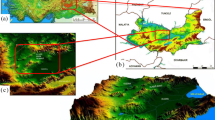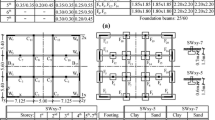Abstract
To define the seismic input in non-liquefiable soils, current seismic standards give the possibility to treat local site effects using a simplified approach. This method is generally based on the introduction of an appropriate number of soil categories with associated soil factors that allow modifying the shape of the elastic acceleration response spectrum computed at rocky (i.e. stiff) sites. Although this approach is highly debated among researchers, it is extensively used in practice due to its easiness. As a matter of fact, for standard projects, this method represents the driving approach for the definition of the seismic input. Nevertheless, recent empirical and numerical studies have risen doubts about the reliability and safety of the simplified approach in view of the tendency of the current soil factors of Italian and European building codes to underestimate the acceleration at the free surface of the soil deposit. On the other hand, for certain soil classes, the current soil factors seem to overestimate ground amplification. Furthermore, the occurrence of soil nonlinearity, whose magnitude is linked to both soil type and level of seismic intensity, highlights the fallacy of using constant soil factors for sites with a different seismic hazard. The objective of this article is to propose a methodology for the definition of hazard-dependent soil factors and simultaneously quantify the reliability of the coefficients specified in the current versions of Eurocode 8 (CEN 2005) and Italian Building Code (NTC8 2008 and revision NTC18 2018). One of the most important outcome of this study is the quantification of the relevance of soil nonlinearity through the definition of empirical relationships between soil factors and peak ground acceleration at outcropping rock sites with flat topological surface (reference condition).


















Similar content being viewed by others
References
Al Atik L, Abrahamson N, Bommer JJ, Scherbaum F, Cotton F, Kuehn N (2010) The variability of ground motion prediction models and its components. Seismol Res Lett 81(5):794–801
Alawneh AS, Nusier OK, Al-Mufty AA (2006) Reliability based assessment of shallow foundations using mathcad. Geotech Geol Eng 24:637–660
Alonso EE (1976) Risk analysis of slopes and its application to slopes in Canadian sensitive clays. Geotechnique 26:453–472
Anderson JG, Brune JN (1999) Probabilistic seismic hazard assessment without the ergodic assumption. Seismol Res Lett 70(1):19–28
Andreotti G, Lai CG (2017) A nonlinear constitutive model for beam elements with cyclic degradation and damage assessment for advanced dynamic analyses of geotechnical problems. Part II: validation and application to a dynamic soil–structure interaction problem. Bull Earthq Eng 15:2803–2825
AndreottiG, Lai CG, Bozzoni F, Scandella L (2013) New soil factors for the Italian Building Code (NTC08) derived from 1D fully stochastic ground response analyses. In: Proceedings XV Symp. L’Ingegneria Sismica in Italia. Padova, ANIDIS
Arnold P, Fenton GA, Hicks MA, Schweckendiek T, Simpson B (2012) Modern Geotechnical design codes of practice. IOS Press, Amsterdam, p 344
Atkinson GM (2006) Single-station sigma. Bull Seismol Soc Am 96(2):446–455
Awojobi AO (1975) The settlement of a foundation on Gibson soil of the second kind. Geotechnique 25(2):221–228
Baecher GB, Christian JT (2003) Reliability and Statistics in geotechnical Engineering. Wiley, Chichester
Barani S, De Ferrari R, Ferretti G, Eva C (2008) Assessing the effectiveness of soil parameters for ground response characterization and soil classification. Earthq Spectra 24(3):565–597
Becker DE (1996) Limit states design for foundations. Part II. Development for national building code of Canada. Can Geotech J 33(6):984–1007
Brejda J, Moorman J, Smith TB, Karlen JL, Allan DL, Dao TH (2000) Distribution and variability of surface soil properties at a regional scale. Soil Sci Soc Am J 64:974–982
Chen Y-H, Tsai C-CP (2002) A new method for estimation of the attenuation relationship with variance components. Bull Seismol Soc Am 92(5):1984–1991
Corigliano M, Lai CG, Rota M, Strobbia C (2012) ASCONA: automated selection of compatibile natural accelerograms. Earthq Spectra 28(3):965–987
Darendeli MB (2001) Development of a new family of normalized modulus reduction and material damping curves. Ph.D. thesis, The University of Texas, Texas
Det Norske Veritas (DNV) (2012) Statistical representation of soil data, recommended practice report DNV-RP-C207, Det Norske Veritas
Duncan JM (2000) Factors of safety and reliability in geotechnical engineering. J Geotech Geoenviron Eng 126:307–316
European Committee for Standardization (CEN) (2005) Part 1: general rules, seismic actions and rules for buildings, Eurocode 8: design of Structures for Earthquake Resistance, EN 1998-1, Brussels
Fenton GA, Griffiths DV (2003) Bearing capacity prediction of spatially random c–ϕ soils. Can Geotech J 40(1):54–65
Fenton GA, Griffiths DV (2008) Risk assessment in geotechnical engineering. Wiley, Hoboken
Gibson RE (1967) Some results concerning displacements and stresses in a non-homogeneous elastic half-space. Geotechnique 17(1):58–67
Gruppo di Mappa di Pericolosità Sismica (GdL MPS) (2004) Redazione della mappa di pericolosità sismica prevista dall’Ordinanza PCM 3274 del 20 marzo 2003, Rapporto conclusivo per il dipartimento di Protezione Civile, INGV, Milano, Roma, 65 pp. +5 appendici, available at http://zonesismiche.mi.ingv.it (in Italian)
Idriss IM (1990) Response of soft soil sites during earthquakes. In: Proceedings H.B. Seed memorial symposium. BiTech Publishers Ltd, Vancouver, pp 273–290
Idriss IM, Sun JI (1992) SHAKE91: a computer program for conducting equivalent linear seismic response analyses of horizontally layered soil deposits. Program modified based on the original SHAKE program published in December 1972 by Schnabel, Lysmer and Seed, Center for Geotechnical Modeling, Department of Civil and Environmental Engineering, University of California, Davis, California
Kaklamanos J, Bradley BB, Thompson EM, Baise LG (2013) Critical parameters affecting bias and variability in site-response analyses using KiK-net downhole array data. Bull Seismol Soc Am 103(3):1733–1749
Kaklamanos J, Baise LG, Thompson EM, Dorfmann L (2015) Comparison of 1D linear, equivalent-linear, and nonlinear site response models at six KiK-net validation sites. Soil Dyn Earthq Eng 69:207–219
Kausel E, Assimaki D (2002) Seismic simulation of inelastic soils via frequency-dependent moduli and damping. J Eng Mech 128(1):34–47
Kottke A, Rathje E (2009) Technical manual for STRATA. PEER report 2008/10 University of California, Berkeley
Lumb P (1970) Safety factors and the probability distribution of soil strength. Can Geotech J 7:225–242
Ministero delle Infrastrutture e dei Trasporti (NTC) (2008) Norme tecniche per le costruzioni, Ministero delle Infrastrutture e dei Trasporti, Decreto Ministeriale del 14 gennaio 2008, Supplemento ordinario alla G.U. n. 29 del 4 febbraio 2008 (in Italian)
Ministero delle Infrastrutture e dei Trasporti (NTC) (2018) Norme tecniche per le costruzioni, Ministero delle Infrastrutture e dei Trasporti, Decreto Ministeriale del 17 gennaio 2018, Supplemento ordinario alla G.U. n. 42 del 20 febbraio 2018 (in Italian)
Mohammadioum B, Pecker A (1984) Low frequency transfer of seismic energy by superficial soil deposits and soft rocks. Earthq Eng Struct Dynam 12:537–564
Morikawa N, Kanno T, Narita A, Fujiwara H, Okumura T, Fukushima Y, Guerpinar A (2008) Strong motion uncertainty determined from observed records by dense network in Japan. J Seismol 12(4):529–546
Peruš I, Fajfar P (2014) Prediction of site factors by a non-parametric approach. Earthq Eng Struct Dyn 43(12):1743–1761
Phoon KK, Kulhawy FH, Grigoriu MD (1995) Reliability based design of foundations for transmission line structures. Report TR-105000. Electric Power Research Institute, PaloAlto
Pitilakis KD, Gazepis C, Anastasiadis A (2006) Design response spectra and soil classification for seismic code provisions. In: Proceedings, ETC-12 workshop, January 20–21, 2006, Athens
Pitilakis K, Riga E, Anastasiadis A (2012) Design spectra and amplification factors for Eurocode 8. Bull Earthq Eng 10(5):1377–1400
Pitilakis K, Riga E, Anastasiadis A (2013) New code site classification, amplification factors and normalized response spectra based on a worldwide ground-motion database. Bull Earthq Eng 11(4):925–966. https://doi.org/10.1007/s10518-013-9440-9
Pitilakis K, Riga E, Anastasiadis A (2015) New design spectra in eurocode 8 and preliminary application to the seismic risk of Thessaloniki, Greece. In: Ansal A, Sakr M (eds) Perspectives on earthquake geotechnical engineering. Geotechnical, geological and earthquake engineering, vol 37. Springer, Cham
Rey J, Faccioli E, Bommer JJ (2002) Derivation of design soil coefficients (S) and response spectral shapes for Eurocode 8 using the European Strong-Motion Database. J Seismol 6(4):547–555
Rota M, Zuccolo E, Taverna L, Corigliano M, Lai CG, Penna A (2012) Mesozonation of the Italian territory for the definition of real spectrum-compatible accelerograms. Bull Earthq Eng 10:1357–1375
Santamarina JC, Klein KA, Fam MA (2001) Soils and waves—particulate materials behavior, characterization and process monitoring. Wiley, Chichester
Seber GAF, Wild CJ (2003) Nonlinear regression. Wiley-Interscience, Hoboken
Seed HB, Idriss IM (1971) Simplified procedure for evaluating soil liquefaction potential. J Soil Mech Found Div 97(9):1249–1273
Suetomi I, Yoshida N (1998) Nonlinear behavior of surface deposit during the 1995 Hyogoken-Nambu earthquake. Soil and Foundations, special issue no. 2, Sep, 11–22
Tobutt DC (1982) Monte Carlo simulation methods for slope stability. Comput Geosci 8:199–208
Wu XZ (2013) Trivariate analysis of soil ranking-correlated characteristics and its application to probabilistic stability assessments in geotechnical engineering problems. Soils Found 53:540–556
Yoshida N, Kobayashi S, Suetomi I, Miura K (2002) Equivalent linear method considering frequency dependent characteristics of stiffness and damping. Soil Dyn Earthq Eng 22(3):205–222
Zembaty Z, Kokot S, Bozzoni F, Scandella L, Lai CG, Kuś J, Bobra P (2015) A system to mitigate deep mine tremor effects in the design of civil infrastructure. Int J Rock Mech Min Sci 1(74):81–90
Acknowledgements
The work presented in this paper was partly supported by the financial contribution of the Italian Department of Civil Protection within the framework “RELUIS-DPC” which is greatly acknowledged by the authors. Special thanks to Francesca Bozzoni, Laura Scandella, Mirko Corigliano and Claudio Strobbia for providing us the earlier version of the stochastic code used in this study. A special word of appreciation goes to Prof. Sebastiano Foti for very fruitful discussions that triggered the idea of writing this article.
Author information
Authors and Affiliations
Corresponding author
Rights and permissions
About this article
Cite this article
Andreotti, G., Famà, A. & Lai, C.G. Hazard-dependent soil factors for site-specific elastic acceleration response spectra of Italian and European seismic building codes. Bull Earthquake Eng 16, 5769–5800 (2018). https://doi.org/10.1007/s10518-018-0422-9
Received:
Accepted:
Published:
Issue Date:
DOI: https://doi.org/10.1007/s10518-018-0422-9




